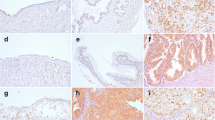Abstract
Interrelationships between HOXA7 expression and ovarian cancer progression are investigated by cDNA array and by immunohistochemistry of normal ovaries and 538 epithelial ovarian tumor microarrays. Outcomes of patients and HOXA7 expression were compared by Kaplan-Meier survival curves. HOXA7 mRNA expression was higher in carcinomas than in benign tumors. HOXA7 protein was absent in normal surface epithelium but appeared in metaplastic regions. All carcinomas stained for HOXA7 protein, with staining intensities unrelated to histotype, grade, or patient outcome. There were significant associations of strong HOXA7 staining of stroma and tumor nuclei with the clear cell histotype (stroma: P =.0022, nuclei: P =.0003) and of weak/absent staining with serous carcinomas. Tumor E-cadherin expression correlated significantly with HOX7 staining in stroma (P =.0002) but not within tumors. HOXA7 staining of tumor cell nuclei is correlated significantly with improved disease-specific survival (P =.0104), which is suggestive of the biological and potentially clinical importance of subcellular HOXA7 localization.
Similar content being viewed by others
References
Centers for Diseases Control and Prevention. 2004/2005. http://www.cdc.gov.
Bast RC Jr, Badgwell D., Lu Z., et al. New tumor markers: CA125 and beyond. Int J Gynecol Cancer. 2005;15(suppl 3): 274–281.
Veraksa A., Del Campo M, McGinnis W. Developmental patterning genes and their conserved functions: from model organisms to humans. Mol Genet Metab. 2000;69:85–100.
Del Bene F., Wittbrodt J. Cell cycle control by homeobox genes in development and disease. Semin Cell Dev Biol. 2005;16:449–460.
Taylor HS, Vanden Heuvel GB, Igarashi P. A conserved Hox axis in the mouse and human female reproductive system: late establishment and persistent adult expression of the Hoxa cluster genes. Biol Reprod. 1997;57:1338–1345.
Naora H., Montz FJ, Chai CY, Roden RB Aberrant expression of homeobox gene HOXA7 is associated with Mullerian-like differentiation of epithelial ovarian tumors and the generation of a specific autologous antibody response. Proc Natl Acad Sci U S A. 2001;98:15209–15214.
Pando SM, Taylor HS Homeobox gene expression in ovarian cancer. Cancer Treat Res. 2002;107:231–245.
Cheng W., Liu J., Yoshida H., Rosen D., Naora H. Lineage infidelity of epithelial ovarian cancers is controlled by HOX genes that specify regional identity in the reproductive tract. Nat Med. 2005;11:531–537.
Ota T., Choi KB, Gilks CB, Leung PC, Auersperg N. Cell type- and stage-specific changes in HOXA7 protein expression in human ovarian folliculogenesis: possible role of GDF-9. Differentiation. 2006;74:1–10.
Gilks CB, Vanderhyden BC, Zhu S., van de Rijn M., Longacre TA Distinction between serous tumors of low malignant potential and serous carcinomas based on global mRNA expression profiling. Gynecol Oncol. 2005;96:684–694.
Tavassoli FA, Devilee P, eds. World Health Organization Classification of Tumours: Pathology and Genetics, Tumours of the Breast and Female Genital Organs. Lyon, France:IARC Press; 2003.
Shimizu Y., Kamoi S., Amada S., et al. Toward the development of a universal grading system for ovarian epithelial carcinoma. I. Prognostic significance of histopathologic features—problems involved in the architectural grading system. Gynecol Oncol. 1998;70(1):2–12.
Feeley KM, Wells M. Precursor lesions of ovarian epithelial malignancy. Histopathology. 2001;38:87–95.
Auersperg N., Pan J., Grove BD, et al. E-cadherin induces mesenchymal-epithelial transition in human ovarian surface epithelium. Proc Natl Acad Sci U S A. 1999;96:6249–6254.
Maines-Bandiera SL, Auersperg N. Increased E-cadherin expression in ovarian surface epithelium: an early step in metaplasia and dysplasia? Int J Gynecol Pathol. 1997;16:250–255.
Kosaka Y., Akimoto Y., Yokozawa K., Obinata A., Hirano H. Localization of HB9 homeodomain protein and characterization of its nuclear localization signal during chick embryonic skin development. Histochem Cell Biol. 2004;122:237–247.
Soubry A., van Hengel J., Parthoens E., et al. Expression and nuclear location of the transcriptional repressor Kaiso is regulated by the tumor microenvironment. Cancer Res. 2005;65: 2224–2233.
Kirito K., Fox N., Kaushansky K. Thrombopoietin induces HOXA9 nuclear transport in immature hematopoietic cells: potential mechanism by which the hormone favorably affects hematopoietic stem cells. Mol Cell Biol. 2004;24:6751–6762.
Komuves LG, Shen WF, Kwong A., et al. Changes in HOXB6 homeodomain protein structure and localization during human epidermal development and differentiation. Dev Dyn. 2000;218:636–647.
Le Page C., Koumakpayi IH, Alam-Fahmy M., Mes-Masson AM, Saad F. Expression and localization of Akt-1, Akt-2 and Akt-3 correlate with clinical outcome of prostate cancer patients. Br J Cancer. 2006;94:1906–1912.
Shah A., Swain WA, Richardson D., et al. Phospho-akt expression is associated with a favorable outcome in non-small cell lung cancer. Clin Cancer Res. 2005;11:2930–2936.
Uegaki K., Kanamori Y., Kigawa J., et al. PTEN-positive and phosphorylated-Akt-negative expression is a predictor of survival for patients with advanced endometrial carcinoma. Oncol Rep. 2005;14:389–392.
Schulze F., Chowdhury K., Zimmer A., Drescher U., Gruss P. The murine homeo box gene product, Hox 1.1 protein, is growth-controlled and associated with chromatin. Differentiation. 1987;36:130–137.
Yamashita T., Tazawa S., Yawei Z., et al. Suppression of invasive characteristics by antisense introduction of overexpressed HOX genes in ovarian cancer cells. Int J Oncol. 2006;28: 931–938.
Author information
Authors and Affiliations
Corresponding author
Additional information
Supported by grants from the National Cancer Institute of Canada with funds from the Canadian Cancer Society to NA and CBG and by graduate scholarships from the B.C. Foundation for Nonanimal Research and Ovarian Cancer Canada to TO.
Rights and permissions
About this article
Cite this article
Ota, T., Gilks, C.B., Longacre, T. et al. HOXA7 in Epithelial Ovarian Cancer: Interrelationships Between Differentiation and Clinical Features. Reprod. Sci. 14, 605–614 (2007). https://doi.org/10.1177/1933719107307781
Published:
Issue Date:
DOI: https://doi.org/10.1177/1933719107307781




